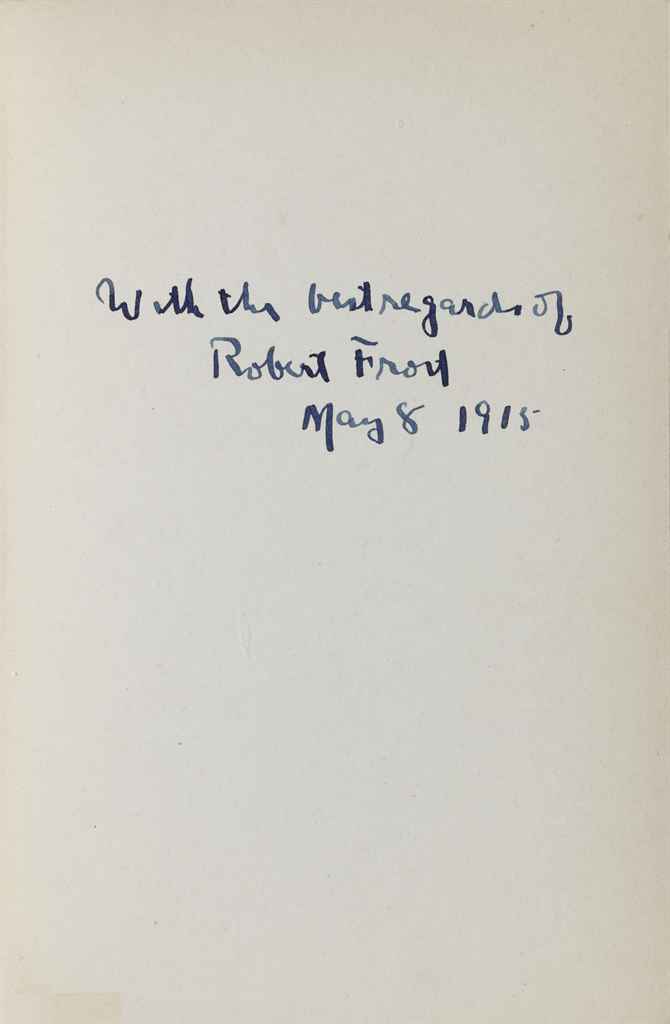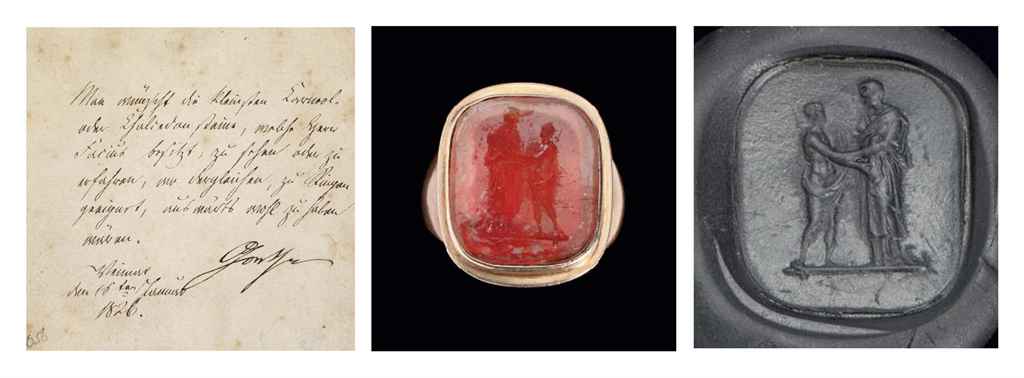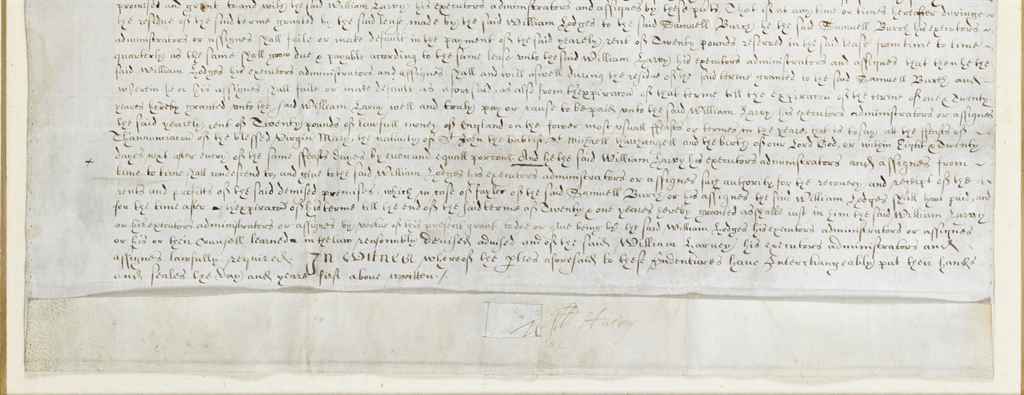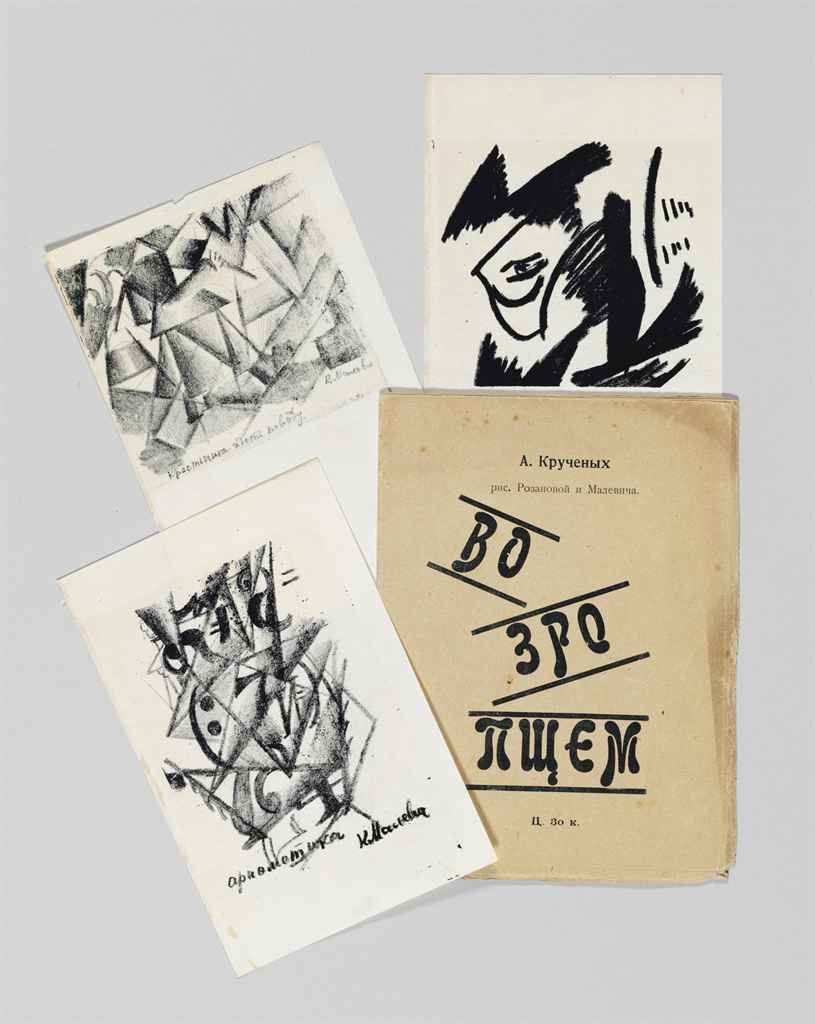HARVEY, William (1578-1657), Physician, discoverer of the circulation of blood . Manuscript document signed ("Will. Harvey"), an indenture between Harvey and William Lodges for the purchase of land in Covent Garden. London, 14 February 1640. 1 page, folio (20 x 21in.), on vellum, scalloped edge, text accomplished in a fine secretarial hand. Signed by Harvey along bottom edge. Archivally framed with the famous 18th century Houbraken portrait of Harvey.
HARVEY, William (1578-1657), Physician, discoverer of the circulation of blood . Manuscript document signed ("Will. Harvey"), an indenture between Harvey and William Lodges for the purchase of land in Covent Garden. London, 14 February 1640. 1 page, folio (20 x 21in.), on vellum, scalloped edge, text accomplished in a fine secretarial hand. Signed by Harvey along bottom edge. Archivally framed with the famous 18th century Houbraken portrait of Harvey. A RARE SIGNATURE OF "WILLIAM HARVEY OF LONDON DOCTOR OF PHISICKE" In this indenture, Harvey and and "William Lodges of Graies Inn" agree to Harvey's acquisition of "All that new bricke messuage or Ten[emen]t situate lying and being in a street called Hart street in Covent Garden," near St. Martin in the Fields. The lengthy document contains considerable detail concerning the precise location of the property, rents to be paid, contract terms, and the names of various individuals involved. It seems likely to represent a significant new source of information for the life of Harvey at the height of his fame. The previous year Harvey had been made senior royal physician with an annual salary of £400 and lodgings in the Palace of Whitehall. Harvey achieved fame with his De Motu Cordis (1628), which announced his discovery and experimental proof of the circulation of the blood. He "conceive[d] the idea of a circulation of the entire blood system, and demonstrated it conclusively by an exhaustive series of dissections and physiological experiments." For twenty years he pursued his researches "and proved experimentally that the blood's motion is continuous and always in one direction, and that its actual amount makes it a physical impossibility for it to do otherwise than to return to the heart by the venous route, the heart being itself a muscle and acting as a pump. He showed how the whole of the blood passes through the lungs, is returned to the left side of the heart, then passes through the general circulation and returns through the right side" ( Printing and the Mind of Man ). In chapter XIV of De Motu Cordis, Harvey presented a confident summary of his conclusions: "I am obliged to conclude that in animals the blood is driven round in a circuit with an unceasing, circular sort of movement, that this is an activity or function of the heart which it carries out by virtue of its pulsation, and that in sum, it constitutes the sole reason for that heart's pulsatile movement." He worried that his discovery was "so novel and unheard of that I not only fear the ill-will of a few but tremble lest old men turn against me. So much do wont and custom become second nature...Still, the die is cast and I put my trust in a love of truth and the clear vision of trained minds." In England's medical circles, Harvey's ideas were well-known and generally accepted, but reaction was mixed abroad. Casper Hofmann, professor of anatomy at Nuremberg, accused Harvey of having "impeached and condemned Nature, of folly and error, and imputed to her the character of the most clumsy and inefficient artificer..." In tones of elaborate yet ironic courtesy, Harvey replied: "Granted that I am not much of an anatomist and a very bad analyst, and that it appears to an upright and learned man that I have slandered Nature; it does not therefore follow that the circulation of the blood is non-existent." Provenance : Bloomsbury, 22 November 2001, lot 6. HARVEY'S SIGNATURE IS VERY RARE.
HARVEY, William (1578-1657), Physician, discoverer of the circulation of blood . Manuscript document signed ("Will. Harvey"), an indenture between Harvey and William Lodges for the purchase of land in Covent Garden. London, 14 February 1640. 1 page, folio (20 x 21in.), on vellum, scalloped edge, text accomplished in a fine secretarial hand. Signed by Harvey along bottom edge. Archivally framed with the famous 18th century Houbraken portrait of Harvey.
HARVEY, William (1578-1657), Physician, discoverer of the circulation of blood . Manuscript document signed ("Will. Harvey"), an indenture between Harvey and William Lodges for the purchase of land in Covent Garden. London, 14 February 1640. 1 page, folio (20 x 21in.), on vellum, scalloped edge, text accomplished in a fine secretarial hand. Signed by Harvey along bottom edge. Archivally framed with the famous 18th century Houbraken portrait of Harvey. A RARE SIGNATURE OF "WILLIAM HARVEY OF LONDON DOCTOR OF PHISICKE" In this indenture, Harvey and and "William Lodges of Graies Inn" agree to Harvey's acquisition of "All that new bricke messuage or Ten[emen]t situate lying and being in a street called Hart street in Covent Garden," near St. Martin in the Fields. The lengthy document contains considerable detail concerning the precise location of the property, rents to be paid, contract terms, and the names of various individuals involved. It seems likely to represent a significant new source of information for the life of Harvey at the height of his fame. The previous year Harvey had been made senior royal physician with an annual salary of £400 and lodgings in the Palace of Whitehall. Harvey achieved fame with his De Motu Cordis (1628), which announced his discovery and experimental proof of the circulation of the blood. He "conceive[d] the idea of a circulation of the entire blood system, and demonstrated it conclusively by an exhaustive series of dissections and physiological experiments." For twenty years he pursued his researches "and proved experimentally that the blood's motion is continuous and always in one direction, and that its actual amount makes it a physical impossibility for it to do otherwise than to return to the heart by the venous route, the heart being itself a muscle and acting as a pump. He showed how the whole of the blood passes through the lungs, is returned to the left side of the heart, then passes through the general circulation and returns through the right side" ( Printing and the Mind of Man ). In chapter XIV of De Motu Cordis, Harvey presented a confident summary of his conclusions: "I am obliged to conclude that in animals the blood is driven round in a circuit with an unceasing, circular sort of movement, that this is an activity or function of the heart which it carries out by virtue of its pulsation, and that in sum, it constitutes the sole reason for that heart's pulsatile movement." He worried that his discovery was "so novel and unheard of that I not only fear the ill-will of a few but tremble lest old men turn against me. So much do wont and custom become second nature...Still, the die is cast and I put my trust in a love of truth and the clear vision of trained minds." In England's medical circles, Harvey's ideas were well-known and generally accepted, but reaction was mixed abroad. Casper Hofmann, professor of anatomy at Nuremberg, accused Harvey of having "impeached and condemned Nature, of folly and error, and imputed to her the character of the most clumsy and inefficient artificer..." In tones of elaborate yet ironic courtesy, Harvey replied: "Granted that I am not much of an anatomist and a very bad analyst, and that it appears to an upright and learned man that I have slandered Nature; it does not therefore follow that the circulation of the blood is non-existent." Provenance : Bloomsbury, 22 November 2001, lot 6. HARVEY'S SIGNATURE IS VERY RARE.















Testen Sie LotSearch und seine Premium-Features 7 Tage - ohne Kosten!
Lassen Sie sich automatisch über neue Objekte in kommenden Auktionen benachrichtigen.
Suchauftrag anlegen